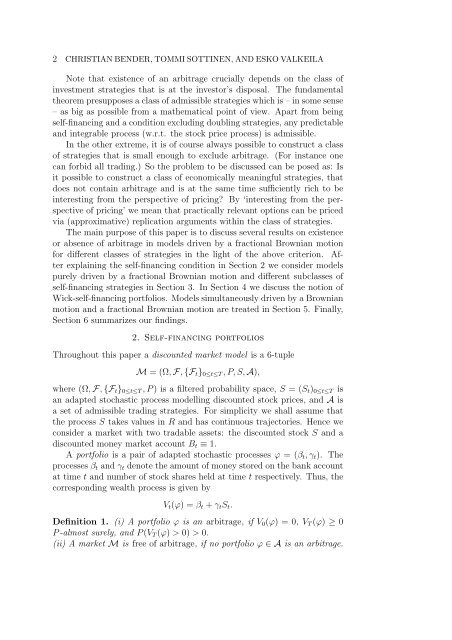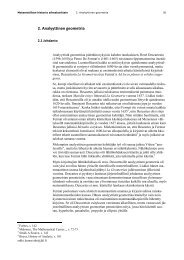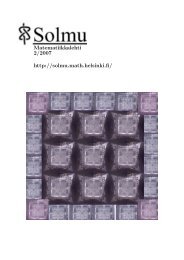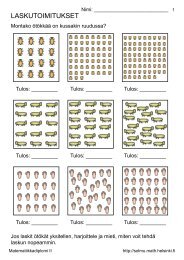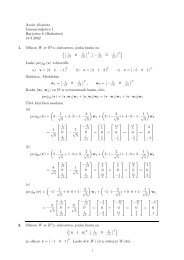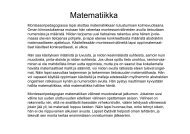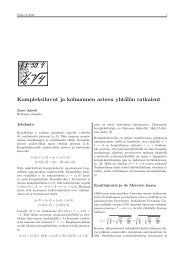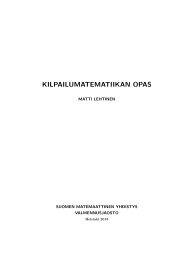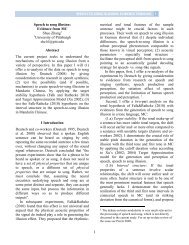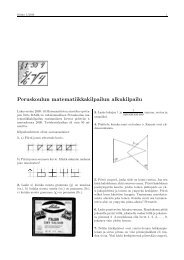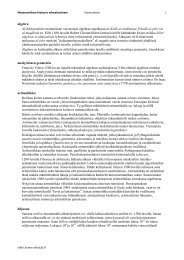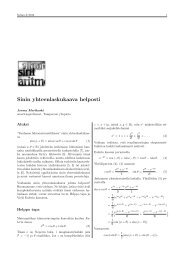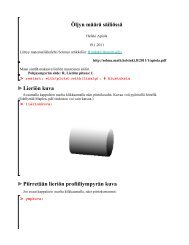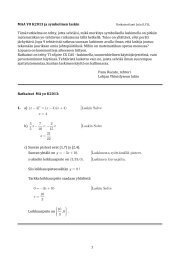ARBITRAGE WITH FRACTIONAL BROWNIAN MOTION?1 - Helsinki.fi
ARBITRAGE WITH FRACTIONAL BROWNIAN MOTION?1 - Helsinki.fi
ARBITRAGE WITH FRACTIONAL BROWNIAN MOTION?1 - Helsinki.fi
Create successful ePaper yourself
Turn your PDF publications into a flip-book with our unique Google optimized e-Paper software.
2 CHRISTIAN BENDER, TOMMI SOTTINEN, AND ESKO VALKEILA<br />
Note that existence of an arbitrage crucially depends on the class of<br />
investment strategies that is at the investor’s disposal. The fundamental<br />
theorem presupposes a class of admissible strategies which is – in some sense<br />
– as big as possible from a mathematical point of view. Apart from being<br />
self-<strong>fi</strong>nancing and a condition excluding doubling strategies, any predictable<br />
and integrable process (w.r.t. the stock price process) is admissible.<br />
In the other extreme, it is of course always possible to construct a class<br />
of strategies that is small enough to exclude arbitrage. (For instance one<br />
can forbid all trading.) So the problem to be discussed can be posed as: Is<br />
it possible to construct a class of economically meaningful strategies, that<br />
does not contain arbitrage and is at the same time suf<strong>fi</strong>ciently rich to be<br />
interesting from the perspective of pricing? By ‘interesting from the perspective<br />
of pricing’ we mean that practically relevant options can be priced<br />
via (approximative) replication arguments within the class of strategies.<br />
The main purpose of this paper is to discuss several results on existence<br />
or absence of arbitrage in models driven by a fractional Brownian motion<br />
for different classes of strategies in the light of the above criterion. After<br />
explaining the self-<strong>fi</strong>nancing condition in Section 2 we consider models<br />
purely driven by a fractional Brownian motion and different subclasses of<br />
self-<strong>fi</strong>nancing strategies in Section 3. In Section 4 we discuss the notion of<br />
Wick-self-<strong>fi</strong>nancing portfolios. Models simultaneously driven by a Brownian<br />
motion and a fractional Brownian motion are treated in Section 5. Finally,<br />
Section 6 summarizes our <strong>fi</strong>ndings.<br />
2. Self-<strong>fi</strong>nancing portfolios<br />
Throughout this paper a discounted market model is a 6-tuple<br />
M = (Ω, F, {F t } 0≤t≤T , P, S, A),<br />
where (Ω, F, {F t } 0≤t≤T , P ) is a <strong>fi</strong>ltered probability space, S = (S t ) 0≤t≤T is<br />
an adapted stochastic process modelling discounted stock prices, and A is<br />
a set of admissible trading strategies. For simplicity we shall assume that<br />
the process S takes values in R and has continuous trajectories. Hence we<br />
consider a market with two tradable assets: the discounted stock S and a<br />
discounted money market account B t ≡ 1.<br />
A portfolio is a pair of adapted stochastic processes ϕ = (β t , γ t ). The<br />
processes β t and γ t denote the amount of money stored on the bank account<br />
at time t and number of stock shares held at time t respectively. Thus, the<br />
corresponding wealth process is given by<br />
V t (ϕ) = β t + γ t S t .<br />
De<strong>fi</strong>nition 1. (i) A portfolio ϕ is an arbitrage, if V 0 (ϕ) = 0, V T (ϕ) ≥ 0<br />
P -almost surely, and P (V T (ϕ) > 0) > 0.<br />
(ii) A market M is free of arbitrage, if no portfolio ϕ ∈ A is an arbitrage.


